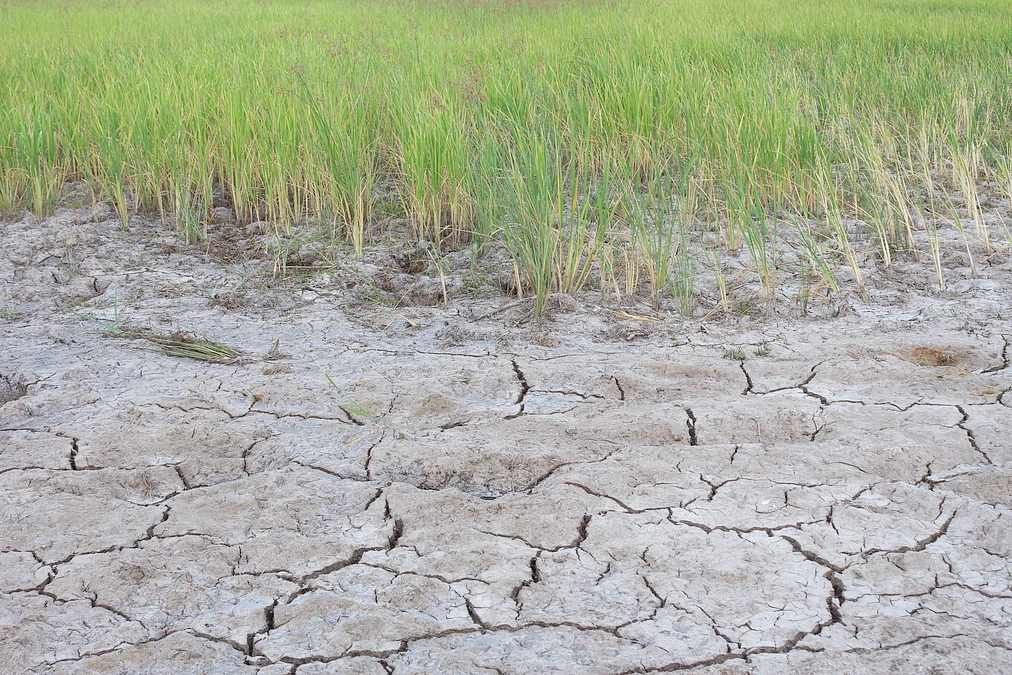Soils of India: Classification, Significance & Recent Crisis
Jul, 2025
•4 min read
Why in the news?
Recent government data indicate that 30% of India's land is affected by severe soil degradation, posing a threat to agricultural productivity and food security.
Why Cover This Topic for UPSC?
- Important for Prelims & Current Affairs
- Relevant for GS Paper III (Agriculture, soil health, food security, & sustainable farming practices).
- Relevant for GS paper I (Physical Geography).
- Essay topics related to environmental themes using soil examples.
What is Soil?
Soil is the loose material or the upper layer of the mantle rock (regolith) consisting of mineral particles, decayed organic matter (humus), water, air, and living organisms. It supports agriculture and sustains half of India's population through farming activities.
Factors that influence soil formation are:
- Parent Material
- Relief/Topography
- Climate
- Natural Vegetation & Biological Factors
- Time
Also cover this important current affairs topic: Prime Minister Dhan-Dhaanya Krishi Yojana
Classification of Soils in India
In India, soil had been classified from the ancient period, and it was based on only two things:
- Urvara (fertile): Soils deemed productive and rich in nutrients.
- Usara (sterile): Soils are considered poor for cultivation and low in fertility.
In recent times, the Indian Council of Agricultural Research (ICAR) has classified Indian soils into eight major types based on their formation, color, composition, and geographical location.

Let’s discuss these major soils of India in the following sections.
1. Alluvial Soil
It is the most widespread soil, covering 45.6% of India's total area. The soil is formed by river sediment deposition. Key characteristics include:
- Formation: Deposited by rivers like the Ganga, the Brahmaputra, and the Indus through flooding and sedimentation processes annually.
- Composition: Rich in potash and lime but deficient in phosphorus; highly fertile with good water retention.
- Color: Light grey to ash grey, depending on organic content and maturity of soil deposits.
- Types: Khadar (new alluvium) and Bhangar (old alluvium) with different fertility levels and compositions.
Distribution:
- Northern Plains: Punjab, Haryana, Uttar Pradesh, Bihar, West Bengal, covering the Indo-Gangetic plain extensively.
- River Valleys: Narmada-Tapi valleys, coastal deltas of the east coast, and narrow Gujarat corridors.
- Total Area: Covers approximately 15 lakh square kilometers across multiple states and union territories.
- Major Crops: Rice, wheat, sugarcane, cotton, jute, tobacco, pulses, and oilseeds are grown extensively.
2. Black Soil (Regur Soil)
Cotton-growing soil covering 16.6% of India, formed from volcanic rocks in the Deccan plateau. Key characteristics include:
- Formation: Developed from weathering of fissure volcanic rocks containing titaniferous magnetite, giving a black color.
- Composition: Rich in iron oxide, aluminum, lime, magnesium, but poor in nitrogen, phosphorus, and organic matter.
- Properties: Highly argillaceous with 62% clay content; excellent moisture retention capacity for dry farming.
- Behavior: Shrinks and develops cracks during the dry season; swells during the monsoon, creating a self-plowing effect.
Distribution:
- Deccan Plateau: Maharashtra, Madhya Pradesh, Gujarat, Karnataka, Andhra Pradesh, Tamil Nadu, covering 5.46 lakh km².
- River Valleys: Krishna and Godavari river valleys with deep black soil deposits suitable for cotton.
- Western India: Parts of Rajasthan and northern Karnataka with varying soil depth and fertility.
- Major Crops: Cotton (black cotton soil), sugarcane, tobacco, wheat, jowar, groundnut, linseed, citrus fruits.
3. Red Soil
Iron-rich soil covering 10.6% of India, formed from crystalline rock weathering. Key characteristics include:
- Formation: Weathering of ancient crystalline and metamorphic rocks under moderate to high rainfall conditions.
- Composition: High iron oxide content giving red color; deficient in nitrogen, phosphorus, and organic matter.
- Properties: Sandy to loamy texture with moderate fertility; requires irrigation and fertilizers for productivity.
- Variations: Color ranges from deep red to yellow based on iron content and drainage conditions.
Distribution:
- Southern States: Tamil Nadu, Karnataka, Andhra Pradesh, parts of Maharashtra, Odisha, and Jharkhand extensively.
- Eastern Regions: Parts of West Bengal, Assam, and northeastern states with varying red soil depths.
- Central India: Chhattisgarh, eastern Rajasthan, and the Bundelkhand region with shallow red soil layers.
- Major Crops: Cotton, groundnut, tobacco, pulses, millets, and cash crops with proper soil management.
4. Laterite Soil
Brick-like soil covering 3.7% of India, formed under high temperatures and rainfall. Key characteristics include:
- Formation: Intense leaching under tropical conditions removes silica, leaving iron and aluminum oxides concentrated.
- Composition: Rich in iron, aluminum, and manganese but poor in lime, nitrogen, phosphorus, and potassium.
- Properties: Hardens like brick when exposed to air; poorly drained and requires fertilization.
- Color: Reddish to brownish hues due to high iron and aluminum oxide content.
Distribution:
- Western Ghats: Kerala, Karnataka, Maharashtra highlands with thick laterite soil layers for plantation crops.
- Eastern Regions: Parts of Assam, West Bengal (Birbhum), Tamil Nadu, and the Eastern Ghats areas.
- Peninsular Plateau: Summit areas and higher elevations with well-developed laterite soil profiles.
- Major Crops: Tea, coffee, rubber, cashew, tapioca, and tropical fruits require acidic soil conditions.
5. Arid/Desert Soil
Sandy soil covers 4.42% of India, found in low rainfall regions. Key characteristics include:
- Formation: Limited weathering due to low rainfall and high evaporation in arid climatic conditions.
- Composition: High calcium carbonate and soluble salts; low organic matter and poor nutrient content.
- Properties: Sandy texture with poor moisture retention; challenging for cultivation without irrigation support.
- Fertility: Generally infertile, requiring extensive soil amendments and water management for crop production.
Distribution:
- Rajasthan: The Thar Desert covers a major portion with sandy soil and low agricultural potential.
- Northwestern India: Parts of Haryana, Punjab, and Gujarat with varying degrees of aridity.
- Indus Valley: Areas near the Pakistan border with similar soil characteristics and challenges.
- Major Crops: Drought-resistant crops like barley, cotton, wheat, millets, and drought-tolerant pulses mainly.
6. Forest Soil
Humus-rich soil is found in forested mountainous regions. Key characteristics include:
- Formation: Accumulation of organic matter from decomposed forest vegetation under moderate to high rainfall.
- Composition: High humus content with good nitrogen, phosphorus, and potassium, but generally acidic.
- Properties: Variable texture from sandy loam to clayey; fertile but requires pH correction.
- Color: Light to dark brown, depending on organic matter content and decomposition stage.
Distribution:
- Himalayan Region: Hill slopes and valleys with coniferous and deciduous forests cover extensively.
- Western Ghats: High rainfall areas with dense forest cover and thick soil organic layers.
- Northeastern States: Assam, Nagaland, Mizoram, Meghalaya, with forest soil supporting diverse vegetation.
- Major Crops: Tea, coffee, spices, fruits, wheat, maize, barley in hill agriculture systems
7. Saline Soil
Salt-affected soil covering 68,000 sq km of area is found in waterlogged and coastal areas. Key characteristics include:
- Formation: Accumulation of salts through evaporation, poor drainage, and seawater intrusion in coastal areas.
- Composition: High sodium, magnesium, and calcium salts make soil alkaline and unsuitable for cultivation.
- Properties: Poor drainage, compact structure hindering root growth and water infiltration significantly.
- Challenges: Requires extensive reclamation through drainage, leaching, and gypsum application for cultivation.
Distribution:
- Northern States: Uttar Pradesh (1.25 million hectares), Punjab (1.21 million hectares), with severe salinity.
- Western Coast: Gujarat around the Gulf of Khambhat with saltwater intrusion affecting agricultural lands.
- Other States: Haryana, Rajasthan, Maharashtra, Bihar, Andhra Pradesh, Karnataka, with varying salinity levels.
- Major Crops: Salt-tolerant crops like barley, cotton, sugar beet, and certain varieties of rice.
8. Peaty Soil
Organic-rich soil is found in waterlogged marshy areas. Key characteristics include:
- Formation: Accumulation of organic matter under waterlogged anaerobic conditions, preventing complete decomposition slowly.
- Composition: High organic matter and nitrogen content, but deficient in phosphorus and potassium.
- Properties: Black color, spongy texture, high water retention, but highly acidic, requiring lime application.
- Challenges: Requires proper drainage and nutrient management for successful crop cultivation and productivity.
Distribution:
- Kerala: Kottayam and Alappuzha districts with extensive peaty soil in backwater regions.
- West Bengal: Sundarbans delta region with marshy conditions and high organic matter accumulation.
- Other Areas: Coastal Odisha, Tamil Nadu, parts of Bihar, and Uttarakhand, with limited distribution.
- Major Crops: Rice, jute, vegetables like cabbage, broccoli, carrots, and other marsh-adapted crops.
Also read: Bharat Forecast System: Launch, Objectives & Key Details.
Multiple Choice Questions
QUESTION 1
Hard
Consider the following statements regarding soil degradation in India:
- According to the Desertification Land Degradation Atlas of India (2021), over 30% of the country’s landmass is degraded.
- The Soil Health Card Scheme involves biennial soil sampling and nutrient analysis for each farmholding.
- The Pradhan Mantri Krishi Sinchayee Yojana promotes on-farm rainwater harvesting and land-levelling to reduce soil erosion. Which of the statements given above are correct?
Select an option to attempt
Understanding the Significance of Indian Soils
India’s varied climate, parent materials, topography, and biological activity have produced eight major soil groups, each playing a unique role in national development.
1. Agricultural Productivity
- Alluvial soils across the Indo-Gangetic plains are highly fertile, supporting staple crops such as rice, wheat, sugarcane, and pulses, and sustaining over 40% of India’s population through farming.
- Black soils in the Deccan trap region retain moisture and are ideal for cotton and oilseeds, bolstering regional agrarian economies.
2. Food Security and Livelihoods
- Nearly 65–70% of India’s rural population depends on agriculture for income and sustenance.
- Healthy soils ensure consistent yields and crop quality, reducing vulnerability to market fluctuations and livelihood insecurity
3. Ecosystem Health and Biodiversity
- Soils host a very large number of microorganisms, insects, and plant roots that maintain nutrient cycling, organic matter decomposition, and soil structure.
- These functions underpin terrestrial ecosystems, supporting wildlife habitats and pollinator populations critical for crop production.
4. Carbon Sequestration and Climate Mitigation
- Organic-rich soils, especially in forested and peaty regions, act as significant carbon sinks.
- Conserving and restoring soil organic carbon can sequester atmospheric CO₂, contributing to India’s climate commitments under the Paris Agreement.
5. Economic Foundation
- Agriculture contributes over 18% of India’s GDP and employs half its workforce.
- Soil fertility directly impacts crop productivity, agricultural exports, and agro-based industries, forming the backbone of the national economy.
6. Raw Materials and Industrial Uses
- Laterite soils supply bauxite for aluminum production; sandy soils support the glass and construction industries.
- Coastal alluvial sediments provide sand and clay for brickmaking and ceramics, linking soil resources to manufacturing sectors.
Underlying Causes of India’s Soil Health Crisis

India, with 18% of the world’s population, depends heavily on agriculture to sustain more than half its people. However, the foundation of this sector, our soil, is in crisis. Recent data shows that around 30% of India’s land is facing serious degradation due to issues like erosion, acidity, and salinity. These growing pressures are putting the productivity and long-term sustainability of Indian agriculture at risk. Here are the key factors contributing to soil degradation.
1. Imbalanced Fertilizer Use
- Heavy reliance on urea subsidies leads to N:P:K ratios of 7.7:3.1:1 instead of 4:2:1.
- Only 35–40% of applied nitrogen is taken up by crops.
2. Nutrient Depletion
- Widespread nitrogen, phosphorus, and potassium shortages across many states.
- Micronutrient (zinc, boron, iron, manganese) deficits are common
3. Soil Erosion
- Loss of 6–12 billion tons of topsoil each year
- Caused by water and wind erosion, deforestation, overgrazing, and intensive tillage
4. Salinization & Waterlogging
- Over-irrigation without proper drainage leads to salt build-up.
- Affects canal-irrigated areas in Punjab, Tamil Nadu, and elsewhere
5. Decline in Soil Organic Matter
- Less than 20% of soils have adequate organic carbon.
- Due to mono-cropping, residue removal, and low organic manure use.
6. Unsustainable Land-Use Practices
- Deforestation for new farmland.
- Overgrazing and shifting cultivation on marginal lands.
Also read: Nutrition in India: Challenges, Schemes, and the Road Ahead
Measures for Soil Health Restoration and Conservation in India
Healthy soil is the backbone of sustainable agriculture, and India’s farming future depends on how well we care for it. As the Food and Agriculture Organization (FAO) states, 95% of the world’s food production relies on healthy soil, making soil conservation crucial for India’s food security and environmental resilience. Let’s understand key measures to restore and protect soil health across India’s diverse agricultural regions.
1. Promoting Integrated Nutrient Management (INM) for Balanced Fertilization
- India should implement Integrated Nutrient Management, combining chemical fertilizers, organic manures, crop residues, biofertilizers, and legumes to maintain soil fertility and optimize nutrient supply.
2. Expanding Agroforestry and Perennial Crop Systems
- Adopting agroforestry practices like alley cropping, silvopasture, and agri-horticulture plays a key role in restoring soil health. Integrating nitrogen-fixing trees improves soil fertility, while tree cover helps reduce soil erosion by up to 94%. Agroforestry also supports carbon storage, capturing 1.8 to 3.5 megagrams of carbon per hectare each year across different regions.
3. Encouraging Zero-Tillage and Conservation Agriculture
- Scaling up zero-tillage in the Indo-Gangetic Plains, now covering nearly 2 million ha, reduces soil disturbance, improves soil structure, and boosts wheat yields by 6–10% while lowering production costs by 5–10%.
4. Restoring Degraded Lands Through Agroecological Approaches
- Implementing agroecological restoration, including intercropping, crop rotation, and using nitrogen-fixing plants like pulses, can naturally boost soil nutrients. Traditional techniques, such as Rajasthan’s Zai pits, small planting holes that trap water and compost, can successfully reverse soil degradation.
5. Strengthening Policy Implementation and Farmer Awareness
- Enhancing policy execution and outreach through Soil Health Card advisories, Krishi Vigyan Kendras, and Farmer-Producer Organizations can improve fertilizer use efficiency.
6. Strengthening Soil Biodiversity and Microbial Rejuvenation
- Promoting microbial rejuvenation via in-situ composting and bioinoculants enriches indigenous microbial biomass, increases soil enzymatic activities (e.g., cellulase, β-glucosidase), and enhances nutrient cycling.
Way Forward
A practical roadmap to restore soil health in India starts with village-level soil testing to guide informed farming practices. Key steps include:
- Balanced use of compost and chemical fertilizers to maintain soil fertility
- Low-impact farming methods, like reduced plowing and cover cropping, are used to retain soil structure and moisture
- Rainwater harvesting and the use of urban compost to return nutrients to the soil
- Digital tools for precision farming, ensuring timely and efficient use of water and fertilizers
As the foundation of resilient agriculture, healthy soils are essential for long-term sustainability. Caring for them today is an investment in the future of generations to come.
Unlock your UPSC success with SuperKalam! Get instant doubt clearance, customized study plans, unlimited MCQ practice, and fast Mains answer feedback.
Join thousands of aspirants learning with India’s AI-powered mentor today!
Related Blogs
![Vijay Diwas 2025: Why 16 December is Celebrated [UPSC Current Affairs]](/_next/image?url=https%3A%2F%2Fblog-media.superkalam.com%2FVijay_Diwas_2631842d69.jpeg&w=3840&q=75)
Vijay Diwas 2025: Why 16 December is Celebrated [UPSC Current Affairs]
Dec, 2025
•6 min read

Special Intensive Revision (SIR) of Electoral Rolls: Definition, Objectives, Significance, & Challenges
Dec, 2025
•4 min read

UNICEF Day 2025: 79 Years of Global Commitment to Child Rights & Protection
Dec, 2025
•4 min read